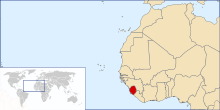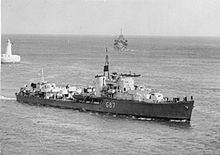Force K
| Force K | |
|---|---|
Force K was the name given to three
Force K (1939)

The
Force K (1941)

Force K was re-created on 21 October 1941, with the

On 19 December, at about the time of the First Battle of Sirte, ships from both forces ran into an Italian minefield (including German deep water mines) while pursuing an Italian convoy.[6] Neptune was sunk and Aurora damaged.[5] The destroyer Kandahar also struck a mine while attempting to assist Neptune and was scuttled the next day by the destroyer Jaguar. Following this and with a resurgence of the Axis aerial bombardment of Malta, the remaining surface ships were withdrawn, except for Penelope, which was too badly damaged to leave. Frequent air attacks while she remained in harbour earned Penelope the nickname "HMS Pepperpot"; the light cruiser sailed for Gibraltar on 8 April 1942, terminating the second Force K.[7]
Force K (1942)

See also
Footnotes
- ^ Roskill 1957, pp. 114–118.
- ^ Playfair et al. 2004, p. 283.
- ^ Playfair et al. 2004a, p. 107.
- ^ Stegemann 2015, p. 718.
- ^ a b Playfair et al. 2004a, p. 115.
- ^ DiNardo 2005, p. 67.
- ^ Playfair et al. 2004a, p. 181.
- ^ Woodman 2000, p. 461; Playfair et al. 2004b, pp. 196–199.
- ^ Playfair et al. 2004b, p. 205.
- ^ Roskill 1962, pp. 341–343.
- ^ Woodman 2000, pp. 459–461.
Bibliography
- DiNardo, R. L. (2005). Germany and the Axis Powers from Coalition to Collapse. Lawrence, KS: ISBN 978-0-7006-1412-7.
- Playfair, I. S. O.; Flynn, F. C.; Molony, C. J. C. & Toomer, S. E. (2004) [1956]. ISBN 1-84574-066-1.
- Playfair, I. S. O.; Flynn, F. C.; Molony, C. J. C. & Gleave, T. P. (2004a) [1960]. Butler, J. R. M. (ed.). The Mediterranean and Middle East: British Fortunes reach their Lowest Ebb (September 1941 to September 1942). History of the Second World War United Kingdom Military Series. Vol. III (pbk. repr. Naval & Military Press ed.). HMSO. ISBN 1-84574-067-X.
- Playfair, I. S. O.; Flynn, F. C.; Molony, C. J. C. & Gleave, T. P. (2004b) [1966]. Butler, J. R. M. (ed.). The Mediterranean and Middle East: The Destruction of the Axis Forces in Africa. History of the Second World War United Kingdom Military Series. Vol. IV. Uckfield: Naval & Military Press. ISBN 1-84574-068-8.
- OCLC 881709135.
- Roskill, S. W. (1962) [1956]. Butler, J. R. M. (ed.). The War at Sea 1939–1945: The Period of Balance. History of the Second World War United Kingdom Military Series. Vol. II (3rd impression ed.). London: OCLC 174453986.
- Stegemann, B.; et al. (2015) [1995]. "Part I Chapter 3: The Strategic Dilemma of the summer and Autumn of 1940: An Alternative or Interim Strategy c. The Offensive against Sidi Barrani". In Falla, P. S. (ed.). The Mediterranean, South-East Europe and North Africa, 1939–1941: From Italy's Declaration of non-Belligerence to the Entry of the United States into the War. ISBN 978-0-19-873832-9.
- ISBN 0-7195-6408-5.
Further reading
- Caruana, Joseph (2006). "The Demise of Force "K"". Warship International. XLIII (1): 99–111. ISSN 0043-0374.
- Groves, Eric (1993). Sea Battles in Close-Up. Vol. II. London: Ian Allan. ISBN 0-7110-2118-X.
- Smith, Peter C; Walker, Edwin (1974). The Battles of the Malta Striking Forces. Sea battles in close-up. London: Ian Allan. ISBN 0-7110-0528-1.
